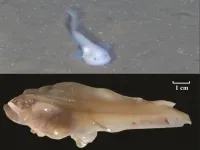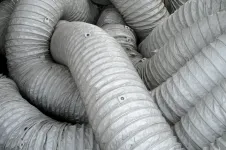Two regions in the canine genome explain one third of the risk of rare blood cancer
Study combines multiple 'omics techniques to investigate cancer risk in flat-coated retrievers
2021-05-13
(Press-News.org) Mutations in two genetic regions in dogs explain over one third of the risk of developing an aggressive form of hematological cancer, according to a study led by Jacquelyn Evans and Elaine Ostrander at the National Human Genome Research Institute in Maryland, USA and colleagues. The study, which combined multiple sequencing techniques to investigate histiocytic sarcoma in retriever dogs, publishes May 13 in the open-access journal PLOS Genetics.
Histiocytic sarcoma is an aggressive cancer of immune cells, and although extremely rare in humans, it affects around one-in-five flat-coated retrievers. Genome-wide association surveys of 177 affected and 132 unaffected flat-coated retrievers identified two loci -- on chromosomes 5 and 19 of the canine genome -- associated with histiocytic sarcoma. Whole genome, transcriptome, and chromatin immunoprecipitation (CHiP) sequence data revealed that the CFA5 locus contains mutations near a known tumor-suppressor gene, PIK3R6. CFA5 also overlaps with two loci previously associated with other hematological cancers in golden retrievers. Risk alleles at the second locus, CFA19, identified by the genome-wide association survey were found to increase expression of TNFAIP6, a gene involved in cell metastasis. TNFAIP6 has also previously been associated with a poor prognosis for several human cancers.
Together, these two chromosomal regions accounted for 35% of the risk of histiocytic sarcoma in flat-coated retrievers, an exceptionally strong effect for such a complex trait, the authors say. By studying this rare cancer in domestic dogs, which have a high disease risk and comparatively low genetic diversity, the researchers hope to identify candidate genes for developing new diagnostics and therapeutics for humans.
"This work identifies two regions of the genome that increase the likelihood of a flat-coated retriever developing histiocytic sarcoma, and highlights genes with tumor suppressor functions in each region," Ostrander adds. "Strategic breeding can be used to reduce the frequency of the disease over time, and genetic observations may lead to therapeutic options for dogs and humans."
INFORMATION:
Peer-reviewed; Experimental study; Animals
In your coverage please use this URL to provide access to the freely available article in PLOS Genetics:
http://journals.plos.org/plosgenetics/article?id=10.1371/journal.pgen.1009543
Citation: Evans JM, Parker HG, Rutteman GR, Plassais J, Grinwis GCM, Harris AC, et al. (2021) Multi-omics approach identifies germline regulatory variants associated with hematopoietic malignancies in retriever dog breeds. PLoS Genet 17(5): e1009543. https://doi.org/10.1371/journal.pgen.1009543
Funding: This work was supported by the Intramural Program of the National Human Genome Research Institute at NIH (https://www.genome.gov/) with partial support from the UK Flatcoated Retriever Society (https://www.flatcoated-retriever-society.org/). JME was supported by a National Institute of General Medical Sciences Postdoctoral Research Associate Training fellowship, award number 1FI2GM133344-01 (https://www.nigms.nih.gov/training/pages/prat.aspx). SEL was funded by The Flint Animal Cancer Center (https://www.csuanimalcancercenter.org/). GRR was partially funded by European Commission, grant number LUPA-GA-201370 (https://ec.europa.eu). The funders had no role in study design, data collection and analysis, decision to publish, or preparation of the manuscript.
Competing Interests: The authors have declared that no competing interests exist.
ELSE PRESS RELEASES FROM THIS DATE:
2021-05-13
A new whole genome sequence for the Yap hadal snailfish provides insights into how the unusual fish survives in some of the deepest parts of the ocean. Xinhua Chen of the Fujian Agriculture and Forestry University and Qiong Shi of the BGI Academy of Marine Sciences published their analysis of the new genome May 13th in the journal PLOS Genetics.
Animals living in deep-sea environments face many challenges, including high pressures, low temperatures, little food and almost no light. Fish are the only animals with a backbone that live in the hadal zone--defined as depths below 6,000 meters--and hadal snailfishes live in at least five separate marine trenches. Chen, Shi and their colleagues constructed a high-quality whole genome sequence from the Yap ...
2021-05-13
Artificial intelligence (AI) learning machines can be trained to solve problems and puzzles on their own instead of using rules that we made for them. But often, researchers do not know what rules the machines make for themselves. Cold Spring Harbor Laboratory (CSHL) Assistant Professor Peter Koo developed a new method that quizzes a machine-learning program to figure out what rules it learned on its own and if they are the right ones.
Computer scientists "train" an AI machine to make predictions by presenting it with a set of data. The machine extracts a series of rules and operations--a model--based on information it encountered during its training. Koo says:
"If you learn general ...
2021-05-13
QUT air-quality expert Distinguished Professor Lidia Morawska is leading an international call for a "paradigm shift" in combating airborne pathogens such as COVID-19, demanding universal recognition that infections can be prevented by improving indoor ventilation systems.
Professor Morawska led a group of almost 40 researchers from 14 countries in a call published in Science for a shift in standards in ventilation requirements equal in scale to the transformation in the 1800s when cities started organising clean water supplies and centralised sewage systems.
The international group of air quality researchers called on the World ...
2021-05-13
For decades, governments worldwide have invested great deals of legislation and resources in food safety, sanitation and drinking water quality for public health purposes. However, the same cannot be said for the air quality of indoor public spaces, wherein the spread of airborne pathogens - whether those that cause the common cold or COVID-19 - is generally considered to be an "inescapable part of daily life." In a Policy Forum, Lidia Morawska and colleagues argue for a profound shift in how policymakers and building engineers view and approach indoor air quality and health, to reduce the spread of respiratory infection. According to Morawska et al., similarly to how food and waterborne disease ...
2021-05-13
A subpopulation of neurons in the brain's zona incerta, or "zone of uncertainty," drives investigatory and novelty-seeking behavior in mice, according to a new study. The findings reveal a previously unknown brain circuit underlying innate curiosity; its discovery may one day have implications as a therapeutic target in animals or people who exhibit novelty-seeking behaviors, authors of a related Perspective say. Although curiosity - the motivational drive to investigate the unknown - is widely considered to be as intrinsic as hunger and thirst, and an ...
2021-05-13
Challenging the assumption that watershed streamflow always recovers from drought, a new study done seven years after the "Millennium Drought," the worst drought ever recorded in southeastern Australia, reports that more than a third of the region's affected watersheds had not yet recovered. Of these watersheds that were still dry seven years later, most showed no evidence of recovering soon, despite the rains' return. The new study's findings suggest that hydrological droughts can persist indefinitely after meteorological droughts, highlighting an amplification of climate change impacts that could present additional challenges to the sustainable use of already-threatened water ...
2021-05-13
More investigation is needed to determine the origin of the COVID-19 pandemic, say Jesse Bloom, Alina Chan, Ralph Baric, David Relman and colleagues in this Letter. "Theories of accidental release from a lab and zoonotic spillover both remain viable," they say. "Knowing how COVID-19 emerged is critical for informing global strategies to mitigate the risk of future outbreaks." The authors highlight a joint China-World Health Organization (WHO) report into the origins of SARS-CoV-2, some results of which were released in November 2020. "WHO Director-General Tedros Ghebreyesus commented that the report's consideration of evidence supporting a laboratory ...
2021-05-13
Humans in the 21st century spend most of their time indoors, but the air we breathe inside buildings is not regulated to the same degree as the food we eat and the water we drink. A group of 39 researchers from 14 countries, including two from the University of Colorado Boulder, say that needs to change to reduce disease transmission and prevent the next pandemic.
In a Perspectives piece published in Science May 14, they call for a "paradigm shift" in combating airborne pathogens such as SARS-CoV-2, the virus that causes COVID-19, demanding universal recognition that respiratory infections can be prevented by improving indoor ventilation systems.
"Air can contain viruses just as water and surfaces do," said co-author Shelly Miller, professor of mechanical and ...
2021-05-13
UNIVERSITY PARK, Pa. -- A plant cell wall's unique ability to expand without weakening or breaking--a quality required for plant growth--is due to the movement of its cellulose skeleton, according to new research that models the cell wall. The new model, created by Penn State researchers, reveals that chains of cellulose bundle together within the cell wall, providing strength, and slide against each other when the cell is stretched, providing extensibility.
The new study, which appears online May 14 in the journal Science, presents a new concept of the plant cell wall, gives insights into plant cell growth, and could provide inspiration for the design of polymeric materials with new properties.
"For a long time, the prevailing ...
2021-05-13
Curiosity is the motivational drive for exploring and investigating the unknown and making new discoveries. It is as essential and intrinsic for survival as hunger. Until recently, the brain mechanisms underlying curiosity and novelty seeking behavior were unclear. However, researchers from the Netherlands Institute for Neuroscience have now discovered a new brain circuit underlying curiosity and novelty seeking behavior. The results have been published in the scientific journal Science.
Curiosity, hunger and appetitive aggression drive three different goal-directed behaviors: novelty seeking, food eating and hunting. In animals these behaviors are composed of similar actions. This similarity of actions has made it challenging ...
LAST 30 PRESS RELEASES:
[Press-News.org] Two regions in the canine genome explain one third of the risk of rare blood cancer
Study combines multiple 'omics techniques to investigate cancer risk in flat-coated retrievers


